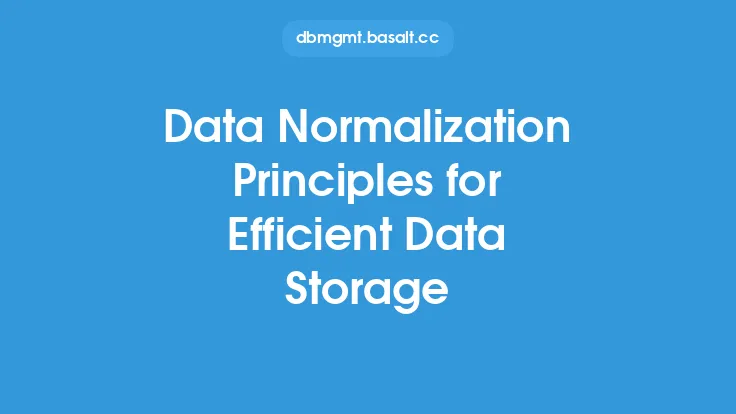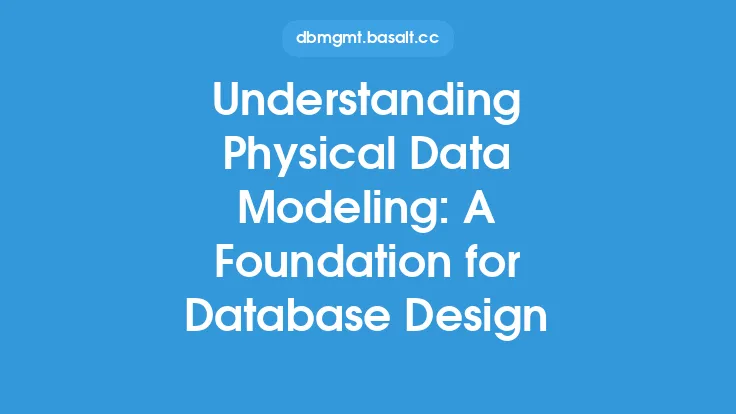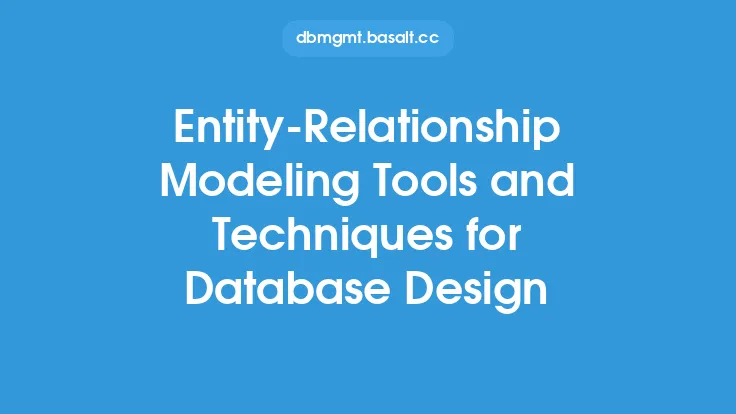When designing a database, one of the most critical steps is to ensure that the data is normalized. Data normalization is the process of organizing data in a database to minimize data redundancy and dependency. Normalization involves dividing large tables into smaller tables and linking them through relationships, which helps to eliminate data anomalies and improve data integrity. In this article, we will explore the various data normalization techniques that can be used to achieve efficient database design.
Introduction to Data Normalization
Data normalization is a technique used to organize data in a database to minimize data redundancy and dependency. The goal of normalization is to ensure that each piece of data is stored in one place and one place only, which helps to eliminate data anomalies and improve data integrity. Normalization involves dividing large tables into smaller tables and linking them through relationships, which helps to reduce data redundancy and improve data consistency.
Types of Data Normalization
There are several types of data normalization, each with its own set of rules and techniques. The most common types of data normalization are:
- First Normal Form (1NF): This is the most basic level of normalization, which states that each table cell must contain a single value.
- Second Normal Form (2NF): This level of normalization states that each non-key attribute in a table must depend on the entire primary key.
- Third Normal Form (3NF): This level of normalization states that if a table is in 2NF, and a non-key attribute depends on another non-key attribute, then it should be moved to a separate table.
- Boyce-Codd Normal Form (BCNF): This level of normalization states that a table is in BCNF if and only if it is in 3NF, and there are no transitive dependencies.
- Higher Normal Forms: There are additional levels of normalization, such as 4NF, 5NF, and 6NF, which deal with more complex relationships and dependencies.
Benefits of Data Normalization
Data normalization offers several benefits, including:
- Elimination of data redundancy: By storing each piece of data in one place and one place only, normalization helps to eliminate data redundancy and improve data consistency.
- Improved data integrity: Normalization helps to ensure that data is consistent and accurate, which improves data integrity and reduces errors.
- Improved scalability: Normalization helps to improve scalability by reducing the amount of data that needs to be stored and processed.
- Improved performance: Normalization can improve performance by reducing the amount of data that needs to be retrieved and processed.
Data Normalization Techniques
There are several data normalization techniques that can be used to achieve efficient database design. Some of the most common techniques include:
- Eliminating repeating groups: This involves eliminating repeating groups of data, such as lists or arrays, and replacing them with separate tables.
- Eliminating redundant data: This involves eliminating redundant data, such as duplicate values or calculated values, and replacing them with separate tables or calculated columns.
- Using surrogate keys: This involves using surrogate keys, such as auto-incrementing IDs, to uniquely identify each row in a table.
- Using foreign keys: This involves using foreign keys to link related tables and establish relationships between them.
Best Practices for Data Normalization
There are several best practices that can be followed to ensure effective data normalization. Some of the most important best practices include:
- Start with a clear understanding of the data: Before normalizing data, it is essential to have a clear understanding of the data and its relationships.
- Use a consistent naming convention: Using a consistent naming convention can help to improve data consistency and reduce errors.
- Use indexes and constraints: Using indexes and constraints can help to improve data integrity and reduce errors.
- Test and validate: Testing and validating data normalization can help to ensure that it is effective and accurate.
Common Challenges and Pitfalls
Data normalization can be challenging, and there are several common pitfalls that can be encountered. Some of the most common challenges and pitfalls include:
- Over-normalization: Over-normalization can lead to complex and difficult-to-maintain databases.
- Under-normalization: Under-normalization can lead to data redundancy and inconsistencies.
- Data inconsistencies: Data inconsistencies can occur when data is not properly normalized, leading to errors and inaccuracies.
- Performance issues: Data normalization can sometimes lead to performance issues, such as slower query times and increased storage requirements.
Conclusion
Data normalization is a critical step in database design, and it is essential to understand the various techniques and best practices involved. By following the principles of data normalization, database designers can create efficient, scalable, and maintainable databases that support business needs and improve data quality. Whether you are designing a new database or optimizing an existing one, data normalization is an essential technique that can help to ensure data consistency, accuracy, and integrity.





